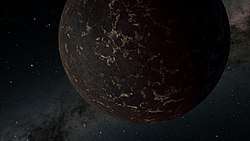LHS 3844 b
LHS 3844 b is an exoplanet orbiting the red dwarf star LHS 3844, discovered using the Transiting Exoplanet Survey Satellite. It orbits its parent star once every 11 hours, and its radius is 1.32 times that of Earth.[1] It has a low albedo, indicating that its surface may resemble that of the Moon or Mercury. LHS 3844 b probably does not have an atmosphere as almost no heat goes to its night side, and it has a dayside temperature of 1,040 K (770 °C; 1,410 °F).[4][5] The presense of cloudy atmosphere with cloud tops above pressure level of 0.1 bar cannot be excluded though.[6]
 Artist’s illustration of LHS 3844 b | |
| Discovery[1] | |
|---|---|
| Discovered by | Vanderspek et al. |
| Discovery date | September 2018 |
| Transit | |
| Designations | |
| TOI-136.01, TIC 410153553 b[2][3] | |
| Orbital characteristics | |
| 0.00622±0.00017 AU[2][3] | |
| 0.46292913±0.00000190 d[2][3] | |
| Inclination | 88.50±0.51[3] |
| Star | LHS 3844 |
| Physical characteristics | |
Mean radius | 1.303±0.022 R⊕[2][3] |
| Albedo | <0.2[4] |
| Temperature | 1,040 K (770 °C; 1,410 °F)[4] |
In order to explain the lack of atmosphere, it has been proposed that the planet was formed interior to the star system's snow-line, because if it formed beyond the snow-line it would have carried volatiles, on the surface and in a thick atmosphere, that according to models on atmospheric loss should have been enough to sustain an atmosphere to the present.[7] The planet probably also formed with a volatile-poor outgassing mantle, in a stagnant lid regime, because if the mantle was similar in constitution to Earth's, with plate tectonics, then it should still have a thick atmosphere, unless the red dwarf star consistently flared at an uncharacteristically extreme rate not yet considered in atmospheric loss models.[7] An alternative explanation for the lack of atmosphere could be through a large impact event, one with enough momentum to strip the planet of its atmosphere and a large portion of its mantle.[7] In order to explain the non replenishment of volatiles via comets back onto the planet, it is also proposed that perhaps there is an outer gas giant in the star system.[7]
References
- Team, the TESS; Villaseñor, Jesus Noel S.; Twicken, Joseph D.; Rose, Mark; Morgan, Edward H.; Pepper, Joshua; Glidden, Ana W.; Fausnaugh, Michael; Davies, Misty D. (2018-09-19). "TESS Discovery of an ultra-short-period planet around the nearby M dwarf LHS 3844". The Astrophysical Journal. 871 (2): L24. arXiv:1809.07242. doi:10.3847/2041-8213/aafb7a.
- "The Extrasolar Planet Encyclopaedia — LHS 3844 b". exoplanet.eu. Retrieved 2019-08-25.
- "LHS 3844 b". NASA Exoplanet Archive. Retrieved 23 July 2020.
- Kreidburg, Laura; et al. (August 2019). "Absence of a thick atmosphere on the terrestrial exoplanet LHS 3844b". Nature. 573 (7772): 87–90. arXiv:1908.06834. doi:10.1038/s41586-019-1497-4.
- Greicius, Tony (2019-08-19). "NASA Gets a Rare Look at a Rocky Exoplanet's Surface". NASA. Retrieved 2019-08-25.
- Optical Transmission Spectroscopy of the Terrestrial Exoplanet LHS 3844b from 13 Ground-Based Transit Observations, 2020, arXiv:2008.05444
- Kane, Stephen R.; Roettenbacher, Rachael M.; Unterborn, Cayman T.; Foley, Bradford J.; Hill, Michelle L. (2020-07-28). "A Volatile-Poor Formation of LHS 3844b based on its Lack of Significant Atmosphere". arXiv:2007.14493.Accepted for publication in the Planetary Science Journal